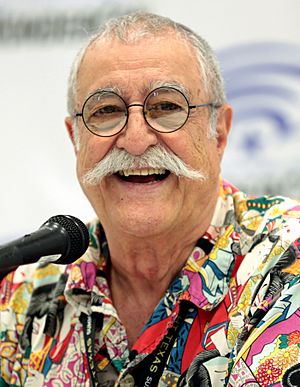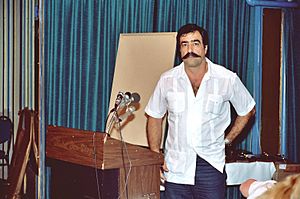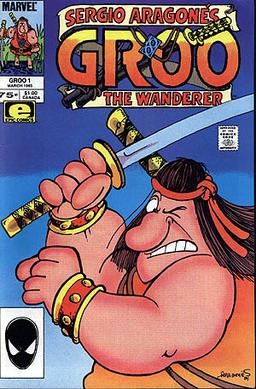Sergio Aragonés facts for kids
Quick facts for kids
Sergio Aragonés
|
|
|---|---|

Aragonés at the 2017 WonderCon
|
|
| Born |
Sergio Aragonés Domenech
6 September 1937 Sant Mateu, Castellón, Spain
|
| Nationality | Spanish |
| Known for | Cartoonist, writer |
|
Notable work
|
Mad, Groo the Wanderer |
| Awards |
List
Shazam Award, Best Inker (Humor Division), and Best Humor Story in 1972;
Inkpot Award 1976; Harvey Award Special Award for Humor in 1990, 1991, 1992, 1993, 1995, 1997, 1998, 1999, and 2001; National Cartoonist Society Comic Book Award for 1986, Humor Comic Book Award for 1973, 1974, and 1976, Magazine and Book Illustration Award for 1989, Special Features Award for 1977, Gag Cartoon Award for 1983, and Reuben Award in 1996; Adamson Award for Best International Comic-Strip or Comic Book work in Sweden, 1985; Eisner Award, Best Short Story in 2001 |
| Signature | |
Sergio Aragonés Domenech (born on September 6, 1937, in Sant Mateu, Spain) is a famous Spanish-Mexican-American cartoonist and writer. He is best known for his funny drawings in Mad magazine. He also created the popular comic book series Groo the Wanderer.
Many people call Aragonés "the world's fastest cartoonist." He is known for drawing very quickly. One magazine, The Comics Journal, called him "one of the most talented cartoonists of his time." The editor of Mad magazine, Al Feldstein, even said that Sergio could have drawn the whole magazine by himself.
Aragonés has won many important awards for his work. These include the Shazam Award, Harvey Award, Inkpot Award, Reuben Award, and Eisner Award. In October 2024, he was added to the Harvey Awards Hall of Fame.
Contents
Early Life and Art Journey
Moving to Mexico
Sergio Aragonés was born in Spain. When he was six years old, his family moved to France. They moved because of the Spanish Civil War. Later, they settled in Mexico.
Discovering a Passion for Drawing
Sergio loved art from a very young age. Once, his parents left him alone with crayons. They came back to find hundreds of drawings covering the wall. Sergio remembered that drawing helped him when he was new in Mexico. He said, "When other kids made fun of me, I stayed home and drew."
First Sales and Education
Aragonés used his drawing skills to make friends and earn money. He would draw pictures for his classmates' homework. He charged them a few pennies for each drawing. This helped him draw very fast.
He made his first professional sale in 1954. A classmate secretly sent his drawings to a magazine. While studying architecture at the National Autonomous University of Mexico, he kept selling cartoons. He also learned pantomime, which helped him draw movement in his comics. In 1962, Aragonés moved to the United States.
Starting Out in the United States
Arriving in New York
In 1962, Sergio Aragonés arrived in New York City with only 20 dollars. He had a portfolio full of his drawings. He worked odd jobs before visiting the offices of Mad magazine. He hoped to sell some of his cartoons there.
Joining the Mad Magazine Team
Sergio did not speak much English at the time. He asked for Antonio Prohías, a Cuban-born artist who worked at Mad. Prohías created the "Spy vs. Spy" comic strip. Sergio hoped Prohías could help him talk to the editors. However, Prohías knew even less English than Sergio.
Despite the language barrier, Mad editor Al Feldstein and publisher Bill Gaines liked Sergio's work. Sergio became a regular contributor to the magazine in 1963. His first drawings were about astronauts.
A Dedicated Artist
Sergio was very eager to work. After his first sale, an editor told him to send more ideas. Sergio drew a whole new article about motorcycle cops overnight. He returned the next morning and made his second sale. He drew about 15 ideas, and the editors loved them.
Sergio spent so much time at the Mad office that the publisher, Bill Gaines, let him sleep there. Sergio worked for Mad continuously from 1963 until 2020. He stopped only when the magazine began reprinting old material. His last new work appeared in an issue filled mostly with his older drawings. He contributed new work to 491 issues, which is an amazing achievement.
Sergio's Famous Marginals
What are Marginals?
Sergio Aragonés is famous for his wordless drawings called "marginals." These small, funny cartoons are placed in the margins of Mad magazine. They also appear between the main comic panels. The drawings can be horizontal or vertical. Sometimes, they even wrap around corners.
Before Sergio, Mad magazine used text jokes in the margins. Sergio showed the editors how his cartoons could fill these spaces. The staff loved his idea. They wondered if he could keep drawing enough small cartoons for every issue.
A Prolific Cartoonist
Sergio has provided marginals for almost every issue of Mad since 1963. Only one issue missed his contributions because his drawings were lost in the mail. An editor once said that Sergio made the job of filling the margins much easier.
Al Jaffee, another famous cartoonist, once joked about Sergio's speed. He said Sergio has drawn more cartoons on napkins than most cartoonists draw in their whole careers. In 2002, writer Mark Evanier estimated that Sergio had drawn over 12,000 gag cartoons just for Mad. As of April 2024, Sergio has contributed to 509 issues of Mad. This makes him the artist with the most contributions to the magazine.
Comic Books and Other Works
Working with DC Comics
In 1967, Sergio began writing and drawing for DC Comics. He worked on titles like The Adventures of Jerry Lewis and Young Romance. He also helped create the Western series Bat Lash and the humor comic Plop!. Sergio often wrote stories that other artists would draw.
Creating Groo the Wanderer
Sergio Aragonés created the funny barbarian comic book Groo the Wanderer in the late 1970s. The character first appeared in print in 1982. Sergio chose the name "Groo" because it meant nothing in any language.
Writer Mark Evanier later joined Sergio on Groo. At first, Evanier helped Sergio express his ideas in English. Over time, they began working together on stories. Sometimes, Evanier was even credited as the only writer. Sergio is now fluent in English. Other regular contributors to Groo include letterer Stan Sakai and colorist Tom Luth.
Groo is a series where the creators own the rights. This means it has continued even when its publishers went out of business. It has been published by several companies, including Pacific Comics, Marvel Comics, Image Comics, and currently Dark Horse Comics.
Other Collaborations
In the early 1980s, Sergio worked with Belgian cartoonist François Walthéry. They created a story for the comic series Natacha, l'hotesse de l'air. Sergio even appeared as a police officer character in the comic.
In April 2022, Sergio was one of many comic creators who helped with Comics for Ukraine: Sunflower Seeds. This book raised money for Ukrainian refugees. His cartoons have also appeared in other collections, like The Big Book of the Weird, Wild West.
Film and Television Appearances
Acting Roles
Sergio Aragonés has also appeared in movies and TV shows. In 1976, he had a role in the film Norman... Is That You?. He played a desk clerk in a hotel. He also appeared in the 1977 TV show Laugh-In.
Animation and TV Segments
Sergio worked on the NBC show Speak Up America in 1980. He would draw during the show. His drawings were also used for many years on Dick Clark's Bloopers programs.
His friend and collaborator Mark Evanier shared a funny story. Sergio once met model Jayne Kennedy on a TV set. She was wearing a very revealing dress. When Sergio walked in, Jayne shouted his name and hugged him. Johnny Carson saw this and thought Sergio, who looked a bit messy, was attacking her. When he found out Sergio was a cartoonist, Johnny joked, "I knew I should have taken up drawing."
In 1991, Stan Lee interviewed Sergio in a documentary series called The Comic Book Greats. Sergio has said, "I'm thinking and laughing all day long."
Voice Acting
Sergio has even lent his voice to animated shows. In 2009, he appeared as his own preserved head in the Futurama episode "Lrrreconcilable Ndndifferences". He hosted a comic book booth at Comic Con 3010. In 2020, he guest-starred in The Casagrandes episode "Mexican Makeover". He voiced Lupe's pet parrot and Sergio's cousin, Paco.
Awards and Recognition

Sergio Aragonés has received many awards for his amazing work.
- He won Shazam Awards in 1972 for his work on Mad Magazine and for a humor story called "The Poster Plague."
- He received an Inkpot Award in 1976.
- He won the Harvey Award Special Award for Humor many times, including in 1990, 1991, 1992, 1993, 1995, 1997, 1998, 1999, and 2001.
- The National Cartoonists Society gave him several awards. These include the Comic Book Award (1986), Humor Comic Book Award (1973, 1974, 1976), and the top Reuben Award in 1996 for his work on Mad and Groo the Wanderer.
- In 1985, he received the Adamson Award in Sweden for his international comic work.
- In 1992, he was the first Mexican to win an Eisner Award for Groo the Wanderer, along with Mark Evanier.
In 2009, an exhibition called Mad About Sergio was held. It showed his cartoons from childhood and some of his awards. Sergio even drew marginal-style sketches directly onto the museum walls.
The Comic Art Professional Society named their award "The Sergio" to honor his contributions. On October 11, 2024, the Harvey Awards announced that Sergio Aragonés would be inducted into their Hall of Fame. He was honored at the 36th annual Harvey Awards ceremony on October 18, 2024. Sergio said he was very honored and that Harvey was a great inspiration to him.
Images for kids
See also
 In Spanish: Sergio Aragonés para niños
In Spanish: Sergio Aragonés para niños





